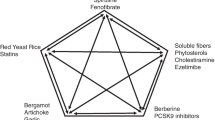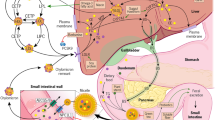Abstract
Numerous randomized clinical trials, systematic reviews and meta-analyses have confirmed the antidyslipidaemic activity of different dietary supplements, nutraceuticals and herbal remedies. International guidelines for cardiovascular disease prevention have begun to consider dietary supplements as an evidence-based approach to improve patients’ plasma lipid levels. They already suggest to increasing or supplementing the dietary intake of soluble fibre (especially psyllium), soy proteins, plant sterols, niacin, and fish oil. Among the nutraceuticals, mevacoline and policosanol are both able to reduce plasma LDL-C by a mean of 20%. A preliminary clinical study of berberine has shown it to be the most powerful antihyperlipidaemic natural compound, reducing plasma LDL-C by 25% and triglycerides by 35%. Among the herbal remedies, several placebo-controlled randomized clinical trials have confirmed the anti-Numerous randomized clinical trials, systematic reviews and meta-analyses have confirmed the antidyslipidaemic activity of different dietary supplements, nutraceuticals and herbal remedies. International guidelines for cardiovascular disease prevention have begun to consider dietary supplements as an evidence-based approach to improve patients’ plasma lipid levels. They already suggest to increasing or supplementing the dietary intake of soluble fibre (especially psyllium), soy proteins, plant sterols, niacin, and fish oil. Among the nutraceuticals, mevacoline and policosanol are both able to reduce plasma LDL-C by a mean of 20%. A preliminary clinical study of berberine has shown it to be the most powerful antihyperlipidaemic natural compound, reducing plasma LDL-C by 25% and triglycerides by 35%. Among the herbal remedies, several placebo-controlled randomized clinical trials have confirmed the antihypercholesterolaemic, and antihypertriglyceridaemic properties of aged garlic powder, artichoke leaf extracts, guggul, and fenugreek. Single small clinical trials have also suggested that Korean ginseng, green tea, onion, yarrow, holy basil and arjun have an antihypercholesterolaemic effect.
Similar content being viewed by others
References
Bean WB (1968) Sir William Osler: Aphorism from his bedside teaching and writing. Thomas, Springfield, IL, p 105
Capasso L (1998) 5300 years ago, the Ice Man used natural laxatives and antibiotics. Lancet 352:1864
Goldman P (2001) Herbal medicine today and the roots of modern pharmacology. Ann Intern Med 135:594–600
Rees L, Weil A (2001) Integrated medicine. BMJ 322:119–120
Astin JA (1998) Why patients use alternative medicine. JAMA 279:1548–1553
Expert Panel on Detection, Evaluation and Treatment of High Blood Cholesterol in Adults (2001) Executive summary of The Third Report of the National Cholesterol Education Program (NCEP) Expert Panel on Detection, Evaluation And Treatment of High Blood Cholesterol In Adults (Adult Treatment Panel III). JAMA 285:2486–2497
Anderson JW, Allgood LD, Lawrence A et al (2000) Cholesterollowering effects of psyllium intake adjunctive to diet therapy in men and women with hypercholesterolemia: meta-analysis of 8 controlled trials. Am J Clin Nutr 71:472–479
Sierra M, Garcia JJ, Fernandez N et al (2002) Therapeutic effects of psyllium in type 2 diabetic patients. Eur J Clin Nutr 56:830–842
Wolever TM, Jenkins DJ, Mueller S et al (1994) Method of administration influences the serum cholesterol-lowering effect of psyllium. Am J Clin Nutr 59:1055–1059
Petchetti L, Frishman WH, Petrillo R, Raju K (2007) Nutriceuticals in cardiovascular disease: psyllium. Cardiol Rev 15:116–122
Moreyra AE, Wilson AC, Koraym A (2005) Effect of combining psyllium fiber with simvastatin in lowering cholesterol. Arch Intern Med 165:1161–1166
Gruppo Italiano per lo Studio della Sopravvivenza nell’Infarto miocardico (1999) Dietary supplementation with n-3 polyunsaturated fatty acids and vitamin E after myocardial infarction: results of the GISSI-Prevenzione trial. Lancet 354:447–455
Bucher HC, Hengstler P, Schindler C, Meier G (2002) N-3 polyunsaturated fatty acids in coronary heart disease: a meta-analysis of randomized controlled trials. Am J Med 112:298–304
Borghi C, Cicero AF (2007) Blood pressure modulating properties of omega-3 polyunsaturated fatty acids (PUFA). Another PUFA heart protective effect? High Blood Pressure Cardiovasc Prevent 14:55–61
Sirtori CR, Lovati MR (2001) Soy proteins and cardiovascular disease. Curr Atheroscler Rep 3:47–53
Anderson JW, Johnstone BM, Cook-Newell ME (1995) Meta-analysis of the effects of soy protein intake on serum lipids. N Engl J Med 333:276–282
Cicero AF, Fiorito A, Panourgia MP et al (2002) Effects of a new soy/beta-sitosterol supplement on plasma lipids in moderately hypercholesterolemic subjects. J Am Diet Assoc 102:1807–1811
Grundy SM (2005) Stanol esters as a component of maximal dietary therapy in the National Cholesterol Education Program Adult Treatment Panel III report. Am J Cardiol 96(1A):47D–50D
Law M (2000) Plant sterols and stanols margarines and heath. BMJ 320:861–864
Hallikainen MA, Sarkkinen ES, Gylling H et al (2000) Comparison of the effects of plant sterol ester and plant stanol ester-enriched margarines in lowering serum cholesterol concentrations in hypercholesterolaemic subjects on a low-fat diet. Eur J Clin Nutr 54:715–725
Patch CS, Tapsell LC, Williams PG, Gordon M (2006) Plant sterols as dietary adjuvants in the reduction of cardiovascular risk: theory and evidence. Vasc Health Risk Manag 2:157–162
Plat J, Mensink RP (2005) Plant stanol and sterol esters in the control of blood cholesterol levels: mechanism and safety aspects. Am J Cardiol 96(1A):15D–22D
Earnest CP, Mikus CR, Lemieux I et al (2007) Examination of encapsulated phytosterol ester supplementation on lipid indices associated with cardiovascular disease. Nutrition 23:625–633
McKenney J (2004) New perspectives on the use of niacin in the treatment of lipid disorders. Arch Intern Med 164:697–705
Levy DR, Pearson TA (2005) Combination niacin and statin therapy in primary and secondary prevention of cardiovascular disease. Clin Cardiol 28:317–320
McCormack PL, Keating GM (2005) Prolonged-release nicotinic acid: a review of its use in the treatment of dyslipidaemia. Drugs 65:2719–2740
Xu G, Huang X, Qiu L et al (2007) Mechanism study of chitosan on lipid metabolism in hyperlipidemic rats. Asia Pac J Clin Nutr 16[Suppl 1]:313–317
Ylitalo R, Lehtinen S, Wuolijoki E et al (2002) Cholesterol-lowering properties and safety of chitosan. Arzneimittelforschung 52:1–7
Lehtimaki T, Metso S, Ylitalo R et al (2005) Microcrystalline chitosan is ineffective to decrease plasma lipids in both apoprotein E epsilon 4 carriers and non-carriers: a long-term placebo-controlled trial in hypercholesterolemic volunteers. Basic Clin Pharmacol Toxicol 97:98–103
Rabinovitz H, Friedensohn A, Leibovitz A et al (2004) Effect of chromium supplementation on blood glucose and lipid levels in type 2 diabetes mellitus elderly patients. Int J Vitam Nutr Res 74:178–182
Broadhurst CL, Domenico P (2006) Clinical studies on chromium picolinate supplementation in diabetes mellitus — a review. Diabetes Technol Ther 8:677–687
Sirtori CR, Calabresi L, Ferrara S et al (2000) L-carnitine reduces plasma lipoprotein(a) levels in patients with hyper Lp(a). Nutr Metab Cardiovasc Dis 10:247–251
Derosa G, Cicero AF, Gaddi A et al (2003) The effect of L-carnitine on plasma lipoprotein(a) levels in hypercholesterolemic patients with type 2 diabetes mellitus. Clin Ther 25:1429–1439
Gunes B, Yalcin SS, Kalkanoglu HS et al (2005) The effect of oral carnitine supplementation on the lipid profiles of hyperlipidemic children. Acta Pediatr 9:711–716
Mason P (2002) Dietary supplements. Pharmaceutical Press, London
Cicero AF, Derosa G, Miconi A et al (2005) Treatment of massive hypertriglyceridemia resistant to PUFA and fibrates: a possible role for the coenzyme Q10? Biofactors 23:7–14
Littarru GP, Langsjoen P (2007) Coenzyme Q and statins: biochemical and clinical implications. Mitochondrion 7:S168–S174
Cicero AF, Brancaleoni M, Laghi L et al (2005) Antihyperlipidaemic effect of a Monascus purpureus brand dietary supplement on a large sample of subjects at low risk for cardiovascular disease: a pilot study. Complement Ther Med 13:273–278
Keithley JK, Swanson B, Sha BE et al (2002) A pilot study of the safety and efficacy of cholestin in treating HIV-related dyslipidemia. Nutrition 18:201–204
Gheith O, Sheashaa H, Abdelsalam M et al (2008) Efficacy and safety of Monascus purpureus Went rice in subjects with secondary hyperlipidemia. Clin Exp Nephrol 12:189–194
Chen JT, Wesley R, Shamburek RD et al (2005) Meta-analysis of natural therapies for hyperlipidemia: plant sterols and stanols versus policosanol. Pharmacotherapy 25:171–183
Berthold HK, Unverdorben S, Degenhardt R et al (2006) Effect of policosanol on lipid levels among patients with hypercholesterolemia or combined hyperlipidemia: a randomized controlled trial. JAMA 295:2262–2269
Dulin MF, Hatcher LF, Sasser HC, Barringer TA (2006) Policosanol is ineffective in the treatment of hypercholesterolemia: a randomized controlled trial. Am J Clin Nutr 84:1543–1548
Cicero AF, Derosa G (2005) Rice bran and its main components: potential role in the management of cardiovascular disease risk. Curr Topics Nutraceut Res 3:29–46
Cicero AF, Martini C, Fiorito A, Gaddi A (2001) Case problem: dietary treatment for children with hyperlipidemia. J Am Diet Assoc 101:693–696
Kong W, Wei J, Abidi P et al (2004) Berberine is a novel cholesterol-lowering drug working through a unique mechanism distinct from statins. Nat Med 10:1344–1351
Doggrell SA (2005) Berberine — a novel approach to cholesterol lowering. Expert Opin Investig Drugs 14:683–685
Cicero AF, Rovati L, Setnikar I (2007) Eulipidemic effects of berberine administered alone or in combination with other natural cholesterol-lowering agents in humans. Arzneimittelforschung 57:26–30
Borek C (2006) Garlic reduces dementia and heart-disease risk. J Nutr 136:810S–812S
Ackermann RT, Mulrow CD, Ramirez G et al (2001) Garlic shows promise for improving some cardiovascular risk factors. Arch Intern Med 161:813–824
Gardner CD, Lawson LD, Block E et al (2007) Effect of raw garlic vs commercial garlic supplements on plasma lipid concentrations in adults with moderate hypercholesterolemia: a randomized clinical trial. Arch Intern Med 26:167:346–353
Thompson Coon JS, Ernst E (2003) Herbs for serum cholesterol reduction. A systematic review. J Fam Pract 52:468–478
Tokunaga S, White IR, Frost C et al (2002) Green tea consumption and serum lipids and lipoproteins in a population of healthy workers in Japan. Ann Epidemiol 12:157–165
Ulbricht C, Basch E, Szapary P et al (2005) Guggul for hyperlipidemia: a review by the Natural Standard Research Collaboration. Complement Ther Med 13:279–290
Buettner C, Yeh GY, Phillips RS et al (2006) Systematic review of the effects of ginseng on cardiovascular risk factor. Ann Pharmacother 39:83–95
Cicero AF, Vitale G, Savino G, Arletti R (2003) Notoginsenoides effects on fibrinogen and lipid plasmatic level in rat submitted to a new model of fat diet. Phytother Res 17:174–178
Adams KE, Cohen MH, Eisenberg D, Jonsen AR (2002) Ethical considerations of complementary and alternative medical therapies in conventional medical settings. Ann Intern Med 137:660–664
Gray CM, Tan AW, Pronk NP, O’Connor PJ (2002) Complementary and alternative medicine use among health plan members. A cross-sectional survey. Eff Clin Pract 5:17–22
Eisenberg DM, Kessler RC, Van Rompay MI et al (2001) Perceptions about complementary therapies relative to conventional therapies among adults who use both: results from a national survey. Ann Intern Med 135:344–351
Owen DK, Lewith G, Stephens CR (2001) Can doctors respond to patients’ increasing interest in complementary and alternative medicine? BMJ 322:154–158
Author information
Authors and Affiliations
Corresponding author
About this article
Cite this article
Cicero, A.F.G., Ertek, S. Natural sources of antidyslipidaemic agents: is there an evidence-based approach for their prescription?. Mediterr J Nutr Metab 1, 85–93 (2008). https://doi.org/10.1007/s12349-008-0011-6
Received:
Accepted:
Published:
Issue Date:
DOI: https://doi.org/10.1007/s12349-008-0011-6




